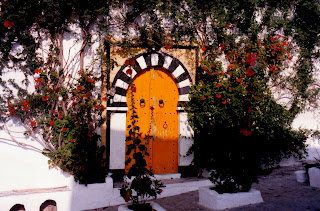Itinerant's Itinerary: Tunis
We visited
Tunis a few years ago, before last year’s Jasmine Revolution. For years, Tunisia was known as a relatively
progressive North African country, with a large middle class, liberal social
norms, broad gender equality, and welcoming Mediterranean beaches. But in January 2011, it launched the wave of revolt that became the Arab spring.
There is regular ferry service across the Mediterranean Sea to Tunis from Italy, a short distance to the north. Libya lies to the east and Algeria to the west.
Tunis is comfortably situated along the southern shores of the Mediterranean Sea
Tunis was known for relatively safe neighborhoods with whitewashed buildings, exterior blue trim, and flat roofs.
A beachside home with traditional colors that looks out over the water
A middle-class residential street in Tunis
The Itinerant Traveller with Itinerant Son and Daughter photographing a traditional home.
One Tunis home we saw broke from tradition with an orange door bordered in black and white
While there,
we were told that women had equal status in society and it was true that we saw
Tunisian women walking the street without traditional dress or male
escorts. However, we never saw Tunisian
women in the coffee shops, restaurants, or retail shops, unless they were
working.
Two women in Tunis dressed very diferently but walking alone without escorts
We saw no Tunisian women customers in restaurants or shops
A woman weaving a rug in a Tunis shop
For all its modern traits, Tunisia had a repressive government and astonishing corruption among its elite that became intolerable once the economic recession of southern Europe spread to the country. When we visited it was illegal to photograph the exteriors of government buildings or the presidential houses, and there were armed guards in the areas to enforce that prohibition.
We took a prohibited photo of the president's beachside home as we drove by
The Tunisian uprising
began in December 2010, when a fruit vendor set himself on fire to protest his
lack of opportunity and the disrespect of the police.
In what
became known as the Jasmine Revolution, street protests ousted the
authoritarian president, Zine el-Abidine Ben Ali, who had ruled with an iron
hand for 23 years. In January 2011, Mr.
Ben Ali left the country, after trying unsuccessfully to placate the
demonstrators with promises of elections. According to government figures
issued later, 78 protesters died and 94 were injured during the demonstrations. In June 2011 he and his wife, Leila Trabelsi,
were convicted in absentia of theft and unlawful possession of cash and
jewelry. The judge in the case sentenced them to 35 years in prison and levied
a $65 million fine.
In the months
after the revolution, Tunisia struggled with continued instability, new
tensions between Islamists and secular liberals, and a still-limping economy. However,
in the country’s first free election, millions of Tunisians cast votes in
October 2011 for an assembly to draft a constitution and shape a new
government. It remains to be seen what
kind of democracy will evolve in Tunisia and how the rights of all citizens
will be restored.
It may be an
opportune time to visit Tunisia, since it is now trying to revive its tourism
industry. Here is a link to a recent NewYork Times article about visiting Tunisia after the revolution and a slide show of recent photographs.












No comments:
Post a Comment